
Previous Articles 2
Below are selected articles published on this site between
January & March 2009. We hope you will find some of interest.
January & March 2009. We hope you will find some of interest.
Articles here have been moved from our Recent Articles & Announcements page and are in reverse chronological order.

Thursday 26 March 2009
Wishful thinking
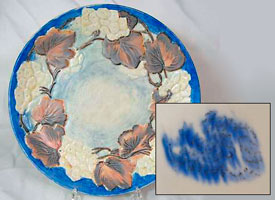
Sellers often make guesses about items they offer, particularly on eBay, and present them as fact. Often, this is wishful thinking.
The plate, or charger on the right, with an embossed leaf pattern, is currently listed on eBay as Carlton Ware. No such shape was made at Copeland Street. The seller suggests that the smudged backstamp, shown in the inset, "maybe cancellation mark". Although the mark is illegible, its outline does not match any known to us. Thank you Derek for this alert.
The plate, or charger on the right, with an embossed leaf pattern, is currently listed on eBay as Carlton Ware. No such shape was made at Copeland Street. The seller suggests that the smudged backstamp, shown in the inset, "maybe cancellation mark". Although the mark is illegible, its outline does not match any known to us. Thank you Derek for this alert.
Scroll down for more.
Wednesday 18 March 2009
BLUSH in the FLESH
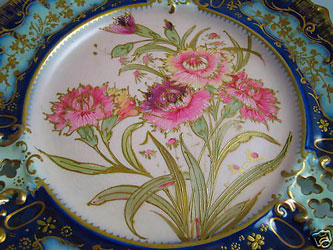
The meeting arranged to view an extraordinary collection of Blush Ware on Sunday 19 April is now fully subscribed.
This elaborate range was some of the earliest Carlton Ware, and produced, approximately, between 1890 and 1913. This is an unparalleled opportunity to see a wide range of these early and sumptuous decorations. We only know of one other collection to match Mike's and that is held in Australia. If only we all had teleportation....Beam us down Scotty.
This elaborate range was some of the earliest Carlton Ware, and produced, approximately, between 1890 and 1913. This is an unparalleled opportunity to see a wide range of these early and sumptuous decorations. We only know of one other collection to match Mike's and that is held in Australia. If only we all had teleportation....Beam us down Scotty.
Carlton Ware World likes to be an inclusive group so do join us for our other meetings. These will also be an opportunity to meet the leading experts on Carlton Ware.
Scroll down for more.
Thursday 12 March 2009
Yet More on Carlton Ware in the Press

Another letter has been printed in the Antiques Trades Gazette about how Carlton Ware counterfeiters have targeted Carlton collectors for at least fifteen years. This one is penned by our Membership Secretary Terry Wise.
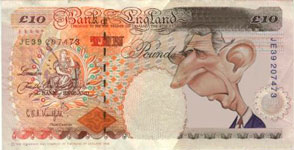
Terry's letter asks those dealers who are happy to sell fakes if they would also be happy to accept payment with "bank notes in the style of the Bank of England!"
Read his well considered letter by clicking here.
Scroll down for more.
Tuesday 10 March 2009
Watt is this?
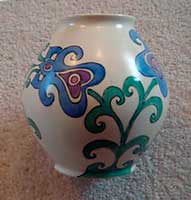
In August last year we reported on an out-decorated Carlton Ware ginger jar painted by artist and craftswoman Elizabeth Mary Watt (1885-1954). Another of her Carlton Ware sourced blanks, which she subsequently decorated has just been sold on eBay.
The decoration on this elegant vase, shape number 463, shows the affinities that Miss Watt had with the Art and Crafts style.
We do not know when the Carlton Ware blank was bought and decorated, but suggest that it is probably in the early to mid 1930s.
The decoration on this elegant vase, shape number 463, shows the affinities that Miss Watt had with the Art and Crafts style.
We do not know when the Carlton Ware blank was bought and decorated, but suggest that it is probably in the early to mid 1930s.
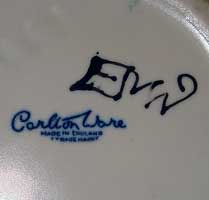
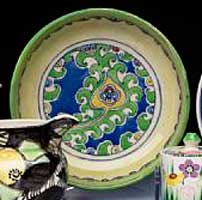
On the right, we show the artist's monogram found on the vase, as well as a similar decoration on a plate of hers from another pottery.
The dominant heart-shaped centre to the stylised flowers is a typical Arts & Crafts motif.
The dominant heart-shaped centre to the stylised flowers is a typical Arts & Crafts motif.
To read our Article on Miss Watt click here.
We know who EMW is, but who is ALH, the monogram found on the small jug below? This too turned up on eBay last week.
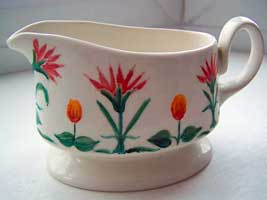
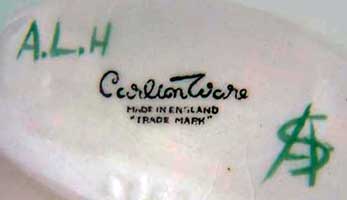
Confusingly, the jug is also monogrammed with an overlapping A and S. In this instance the hand painting is somewhat primitive, as if done by a novice. We will add this to our gallery of monogrammed wares, which you can view by clicking here.
© Harvey Pettit 2009.
© Harvey Pettit 2009.
Scroll down for more.
Thursday 5 March 2009
Tackling the Trade in Counterfeit Carlton Ware

Over the last month, The Antiques Trades Gazette (ATG) has published numerous letters about fakes, sparked off by the recent spate of fake Troika, about which we wrote in January.
This week, a letter was printed from Carlton Ware World's committee member Helen Martin about Carlton Ware fakes. Alarmingly, in letters to the ATG some thought that selling fakes was acceptable. If you would like to read Helen's poignant observations click here.
This week, a letter was printed from Carlton Ware World's committee member Helen Martin about Carlton Ware fakes. Alarmingly, in letters to the ATG some thought that selling fakes was acceptable. If you would like to read Helen's poignant observations click here.
Scroll down for more.
Wednesday 4 March 2009
Writing on the Wall Pocket!
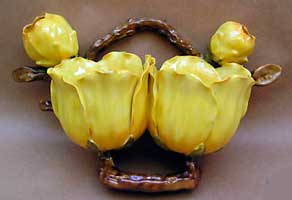
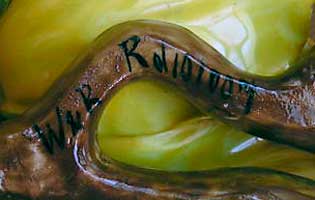
This majolica wall pocket, marked with a handwritten W&R and Rd 101007, appeared on eBay this week. We can all easily jump to wrong conclusions, as the seller has done here by cautiously suggesting that the W&R stands for Wiltshaw & Robinson.
Other pottery manufacturing partnerships with the same initials would have also used W&R. Two examples are Wright & Rigby of Hanley and Wittman & Roth, importers of pottery, both trading in the late nineteenth century. No doubt there were others.
Who made this wall pocket we do not know but it certainly isn't our W&R. The Registered Number 101007, if this is what it is, dates the piece to 1888, which is before Wiltshaw and Robinson moved into the Copeland Street works. © HP 2009
The wall pocket did not sell first time and has been relisted. You can view the sale on eBay by clicking here.
Other pottery manufacturing partnerships with the same initials would have also used W&R. Two examples are Wright & Rigby of Hanley and Wittman & Roth, importers of pottery, both trading in the late nineteenth century. No doubt there were others.
Who made this wall pocket we do not know but it certainly isn't our W&R. The Registered Number 101007, if this is what it is, dates the piece to 1888, which is before Wiltshaw and Robinson moved into the Copeland Street works. © HP 2009
The wall pocket did not sell first time and has been relisted. You can view the sale on eBay by clicking here.
Scroll down for more.
Friday 20 February 2009
Book Review
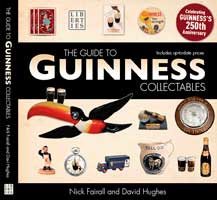
As promised, here is our review of The Guide to Guinness Collectables. Published in November 2008 to celebrate the 250th anniversary of Guinness, this book was originally available only to members of the Guinness Collectors Club. The format is hardback with 288 full colour pages detailing Guinness collectables of all types including, clocks, bottles, bottle openers, ties, etc etc.
Of particular interest to us is the section on those made by Carlton Ware. The majority of items made by our favourite pottery are listed and illustrated - The Cochrane & Pettit Archive of Carlton Ware catalogues only twelve that are not.
Of particular interest to us is the section on those made by Carlton Ware. The majority of items made by our favourite pottery are listed and illustrated - The Cochrane & Pettit Archive of Carlton Ware catalogues only twelve that are not.
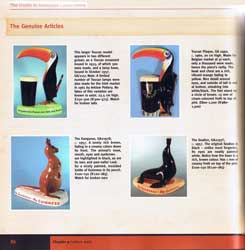
Most entries have good descriptions and a price guide. In some cases the number of pieces made are given, as well as their approximate year of introduction. Unfortunately, the Carlton Ware shape numbers are not included, which would have been even more thorough and assisted identification more easily. A sample page is shown on the right.
There is also a page on fakes, though since there are now so many it would be a tall order to list more than a selection, as is the case here. The 1997 story on the demise of one of the forgers is recounted. The illustrations, over the 15 pages devoted to Carlton Ware, make this book especially useful at avoiding fakes, which are always inferior to the originals.
There is also a page on fakes, though since there are now so many it would be a tall order to list more than a selection, as is the case here. The 1997 story on the demise of one of the forgers is recounted. The illustrations, over the 15 pages devoted to Carlton Ware, make this book especially useful at avoiding fakes, which are always inferior to the originals.
This well researched hardback sells for £25 plus £5 p&p through the Guinness Collectors Club (GCC). To buy a copy this way, it is necessary to join first, either as a Standard member, which is free, or as a full member at £7 or $12 (USD). To go to the GCC site click here.
Copies can also be bought from Blackwells, Foyles, Waterstones, WH Smith and Amazon, all at £26.99, and all with free delivery (probably UK only, but check).
© Derek Towns 2009.
Copies can also be bought from Blackwells, Foyles, Waterstones, WH Smith and Amazon, all at £26.99, and all with free delivery (probably UK only, but check).
© Derek Towns 2009.
Thank you Derek for your review - we know you are always in the groove, confirmed by the security camera that recorded you in the music department of the bookshop. Before viewing make sure you sound is on and then click here. Awesome! We shall expect a repeat performance at the annual get-together in October! Ed.
Scroll down for more.
Monday 16 February 2009
A Word of Warning
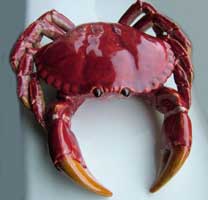
Descriptions by some sellers on eBay can often be misleading, to say the least, so we urge you to take great care when reading them.
A good example of this is the recent sale of the crab shown on the left, which was listed as a large Carlton Ware crab dish with the Carlton Ware stamp underneath.
The seller did not provide a picture of the back, and although we were certain it was not Carlton Ware, we emailed the seller for one, suspecting a fake mark.
The vendor replied that it was too feint to photograph!
A good example of this is the recent sale of the crab shown on the left, which was listed as a large Carlton Ware crab dish with the Carlton Ware stamp underneath.
The seller did not provide a picture of the back, and although we were certain it was not Carlton Ware, we emailed the seller for one, suspecting a fake mark.
The vendor replied that it was too feint to photograph!
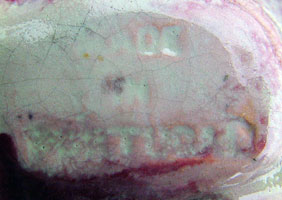
On receipt of the crab, the buyer contacted Carlton Ware World asking us if it was Carlton Ware. She sent a picture of the base, which we show on the right.
The crab is typical of majolica-type ware made for the continental seaside tourist market in places like Italy, Spain and Portugal. Indeed close inspection of the mark reveals that it probably says MADE IN PORTUGAL. How the seller interpreted this as Carlton Ware is a mystery.
In this instance, we advise the buyer to contact the seller about the erroneous description and ask to be refunded.
So, if you buy off the internet, do not take descriptions by seller as necessarily being accurate. Email them for more details and pictures, especially the later since they rarely lie, unless they have been Doctored!
If you would like to view the sale of the crab, which sold for £37 including p&p, click here.
The crab is typical of majolica-type ware made for the continental seaside tourist market in places like Italy, Spain and Portugal. Indeed close inspection of the mark reveals that it probably says MADE IN PORTUGAL. How the seller interpreted this as Carlton Ware is a mystery.
In this instance, we advise the buyer to contact the seller about the erroneous description and ask to be refunded.
So, if you buy off the internet, do not take descriptions by seller as necessarily being accurate. Email them for more details and pictures, especially the later since they rarely lie, unless they have been Doctored!
If you would like to view the sale of the crab, which sold for £37 including p&p, click here.
Scroll down for more.

Sunday 8 February 2009
JACOBEAN FIGURES Vase sold again
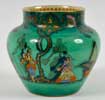
The JACOBEAN FIGURES vase, which was sold by the Dorset based auction house Chaterhouse two weeks ago for £620 plus commission was resold on eBay yesterday for an astonishing £1,757. You can read our article on this unusual vase by scrolling down this page.
Scroll down for more.
Sunday 8 February 2009
Unfinished Business
The decorating process for Best Ware involved many stages, which is why it is was so expensive to make, and thus buy. When something went wrong along the way, such as a fault during one of the many firings, then the item would be rejected and sold cheaply as a second.
These rejects give us a good insight into how ware was decorated. Two good examples of these unfinished items appeared on eBay this week.
These rejects give us a good insight into how ware was decorated. Two good examples of these unfinished items appeared on eBay this week.
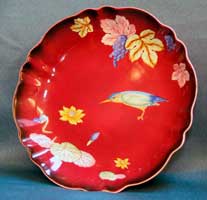
The first is the Kingfisher & Vine bowl on the right. It has been underglaze printed and painted, as well as having the first stages of its ground colour applied.
Below, left, is a close-up of the Kingfisher on this bowl. By comparing it with the Kingfisher on the right, taken from a finished example, you will notice that the first bird is missing its gold printed outline, as well as some orange enamel. The gold branch, on which it should sit is also missing. The gold line to the edge of the bowl is also absent. Notice too that the Ruby Lustre has not been applied to the bowl, evident by a level of flatness, though it has been glazed.
Below, left, is a close-up of the Kingfisher on this bowl. By comparing it with the Kingfisher on the right, taken from a finished example, you will notice that the first bird is missing its gold printed outline, as well as some orange enamel. The gold branch, on which it should sit is also missing. The gold line to the edge of the bowl is also absent. Notice too that the Ruby Lustre has not been applied to the bowl, evident by a level of flatness, though it has been glazed.
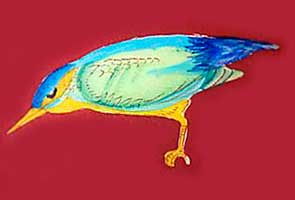
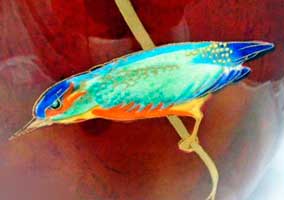
The bowl was originally sold on eBay by the Douglas Macmillan Hospice, but has been relisted by a subsequent buyer. You can view the resale by clicking here.
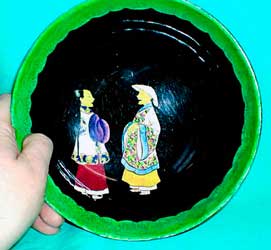
The second example, shown on the right, is more obviously incomplete. It is described by the vendor as:-
A wonderful Stunning Mega Rare Carlton Ware Handpainted Bowl...I have never seen this design anywhere so I believe is a VERY SCARCE PIECE.
Ebay sellers often wax lyrical and speculate about their offerings, hoping it will encourage us to pay more!
The pattern is Madarins Chatting and the decoration has reached the same stage as the Kingfisher & Vine bowl above.
Again, below, we show a close-up alongside the completed decoration of the two Madarins. Here too, the gold print is missing, as well as on the onglaze orange enamel. The Ruby Lustre, which on this pattern is used only on the trousers to the figure on the left, is also missing. The picture on the far right shows a vase with the completed pattern. The elaborate gold printed and enamelled border and tree should have been present on the unfinished bowl.
A wonderful Stunning Mega Rare Carlton Ware Handpainted Bowl...I have never seen this design anywhere so I believe is a VERY SCARCE PIECE.
Ebay sellers often wax lyrical and speculate about their offerings, hoping it will encourage us to pay more!
The pattern is Madarins Chatting and the decoration has reached the same stage as the Kingfisher & Vine bowl above.
Again, below, we show a close-up alongside the completed decoration of the two Madarins. Here too, the gold print is missing, as well as on the onglaze orange enamel. The Ruby Lustre, which on this pattern is used only on the trousers to the figure on the left, is also missing. The picture on the far right shows a vase with the completed pattern. The elaborate gold printed and enamelled border and tree should have been present on the unfinished bowl.
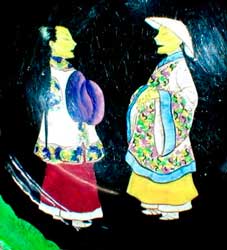
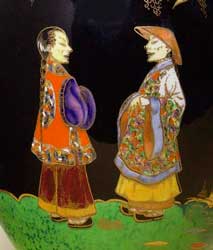
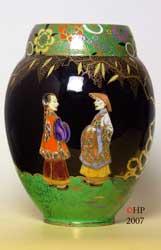
You can view the sale of the bowl by clicking here.
Carlton Ware World hopes this article will help you identify unfinished examples so that you pay an appropriate price for them. Sometimes they can be mistaken for rare pattern variants, which they are not. © Harvey Pettit 2009
Carlton Ware World hopes this article will help you identify unfinished examples so that you pay an appropriate price for them. Sometimes they can be mistaken for rare pattern variants, which they are not. © Harvey Pettit 2009
Scroll down for more.
Wednesday 4 February 2009
Clowning About
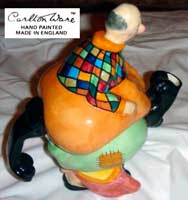
Last week, we were asked about a TWO CLOWNS teapot, shown on the left, which appeared for sale on the Internet. The query was made because the decoration was not recognized as that used at Copeland Street. Two decorations were used on the works, one with parts of the clowns in black, and the other in bright reds and yellows. Was this different one a fake, therefore?
The backstamp, shown in the inset, is a Script mark with the additional TM (Trade Mark) above the e of Ware. This tells us that it was from the stable of Frank Salmon, the current owner of the trade mark, which he bought in 1997.
So, fake it is not, though it was made long after those made at the Copeland Street pottery, which shut its doors in 1989.
The backstamp, shown in the inset, is a Script mark with the additional TM (Trade Mark) above the e of Ware. This tells us that it was from the stable of Frank Salmon, the current owner of the trade mark, which he bought in 1997.
So, fake it is not, though it was made long after those made at the Copeland Street pottery, which shut its doors in 1989.
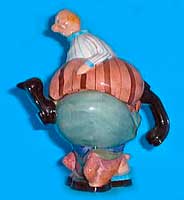
The TWO CLOWNS teapot (named thus in sales literature) was part of Carlton Ware's CIRCUS range, which was designed and modelled by Roger Michell, who owns the copyright.
Mr. Salmon, presumably unaware of Roger Michell's ownership, and in possession of the moulds, commissioned the teapot's re-manufacture, probably by Bairstow Manor Pottery, until the moulds were reclaimed by their rightful owner. Another, but differently decorated pot for Mr. Salmon is shown on the right, courtesy of Sue Blazye at Teapot Island. It is thought that about 100 were made, though this estimate may be wrong.
Mr. Salmon, presumably unaware of Roger Michell's ownership, and in possession of the moulds, commissioned the teapot's re-manufacture, probably by Bairstow Manor Pottery, until the moulds were reclaimed by their rightful owner. Another, but differently decorated pot for Mr. Salmon is shown on the right, courtesy of Sue Blazye at Teapot Island. It is thought that about 100 were made, though this estimate may be wrong.
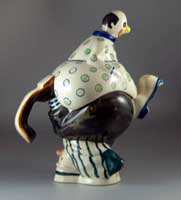
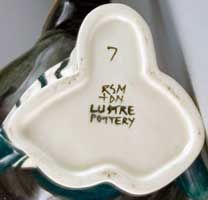
After Roger took possession of the moulds, using them he made a small number of TUMBLING CLOWN teapots, as he called them, at his Lustre Pottery studio, then in Cornwall.
Six were painted by Danka Napiorkowska and one of these is shown on the left with Roger and Danka's monograms.
The last ten from this edition were decorated by Roger. Subsequently, the edition was closed and the moulds publically destroyed in a spectacular way at the 1998 annual conference by the Lord Mayor of Stoke.
It really is the most inspired design. Very cleverly, the shoes of one clown forms the spout and the even larger shoes of the other forms the handle.
We apologize for not showing you pictures of the two original Carlton Ware/Lustre Pottery examples. We can't find them! If we do, we will add them to this article.
If you have pictures of them please send them to us. © Harvey Pettit & Helen Martin.
We would like to thank Roger Michell of Lustre Pottery for some of the information used in this article and for permission to use his images. To see more of his unique work click here.
Six were painted by Danka Napiorkowska and one of these is shown on the left with Roger and Danka's monograms.
The last ten from this edition were decorated by Roger. Subsequently, the edition was closed and the moulds publically destroyed in a spectacular way at the 1998 annual conference by the Lord Mayor of Stoke.
It really is the most inspired design. Very cleverly, the shoes of one clown forms the spout and the even larger shoes of the other forms the handle.
We apologize for not showing you pictures of the two original Carlton Ware/Lustre Pottery examples. We can't find them! If we do, we will add them to this article.
If you have pictures of them please send them to us. © Harvey Pettit & Helen Martin.
We would like to thank Roger Michell of Lustre Pottery for some of the information used in this article and for permission to use his images. To see more of his unique work click here.
Scroll down for more news.
Wednesday 28 January 2009
Troika Pottery collectors suffer too.
The Antiques Trades Gazette (ATG) reported this week that counterfeit Troika is being offered for sale on eBay. There are distinct parallels with many Carlton Ware fakes, where original moulds have found their way into unscrupulous hands. The ATG informs us:-
When the Troika pottery in Newlyn closed its doors in 1983, its moulds and a quantity of undecorated biscuit wares were secured for posterity, not in a local museum or the collection of a Troika devotee, but in a garden shed in Northumberland. Having failed in a quiet attempt to find a single buyer for the collection in its entirety, the owner has sold it piecemeal via a number of outlets...
Like Carlton Ware fakes made from original moulds, the decoration is poor. Despite this inferiority, the counterfeits have often been sold recently for substantial amounts by a Stoke-on-Trent based seller. This begs the question is this the same person faking Carlton? The ATG article ends
EBay have yet to act on their complaints, although police are now considering an investigation.
To read more about the Troika fakes from the ATG click here.
When the Troika pottery in Newlyn closed its doors in 1983, its moulds and a quantity of undecorated biscuit wares were secured for posterity, not in a local museum or the collection of a Troika devotee, but in a garden shed in Northumberland. Having failed in a quiet attempt to find a single buyer for the collection in its entirety, the owner has sold it piecemeal via a number of outlets...
Like Carlton Ware fakes made from original moulds, the decoration is poor. Despite this inferiority, the counterfeits have often been sold recently for substantial amounts by a Stoke-on-Trent based seller. This begs the question is this the same person faking Carlton? The ATG article ends
EBay have yet to act on their complaints, although police are now considering an investigation.
To read more about the Troika fakes from the ATG click here.
Scroll down for more.
Monday 26 January 2009
JACOBEAN FIGURES
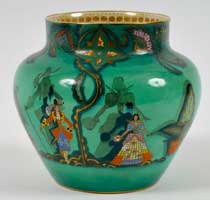
In January 2009, The Antiques Trades Gazette (ATG) reported on an unusual Carlton Ware vase decorated with the JACOBEAN FIGURES pattern for sale at the Charterhouse rooms in Dorset. It sold for £620 plus commission.
Erroneously, the report says that it was not produced commercially probably because of the fiddly, time consuming, harlequin-like application of coloured enamels to the figures costumes.' We know that complexity of design rarely stopped Cuthbert Wiltshaw from introducing Best Ware patterns, whatever the cost of producing them!
Erroneously, the report says that it was not produced commercially probably because of the fiddly, time consuming, harlequin-like application of coloured enamels to the figures costumes.' We know that complexity of design rarely stopped Cuthbert Wiltshaw from introducing Best Ware patterns, whatever the cost of producing them!
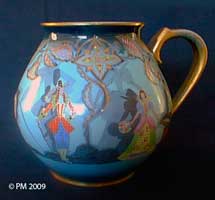
The Cochrane & Pettit Archive of Carlton Ware (C&P A) tells us that factory pattern records also list variants with a sky blue ground and a Ruby Lustre ground.
This is also confirmed by both versions having been seen before. Indeed, because of this article, Peter Meyer from Melbourne in Australia sent us the image of the jug-vase on right employing the sky blue ground, which he bought some years ago. If you have an example in the Ruby Lustre ground then do send us a picture and we can add it to this article.
The misinformation in the ATG report that it was not produced commercially may have come from the vendor, wishing to increase its value, although it is a rarely seen pattern. JACOBEAN FIGURES, is the proper name, since this is recorded in factory records (source C&P A).
Designed by Violet Elmer in the late 1930s, it reflects the pre-war cinema’s fascination with historical themes and period drama. The classic Scarlet Pimpernel, from 1934, with Leslie Howard and Merle Oberon, is a good example. Have a quick look by clicking here. You only need watch the first 50 seconds, unless you are captivated by the film clips.
Coincidently, the ATG report mentions the background shadows, which we discussed in the Flora & Faun article, which you can read below, though this observation may have come from this site. © Harvey Pettit 2009
Scroll down for more.

Friday 16 January 2009
Fakers are still gunning for us!
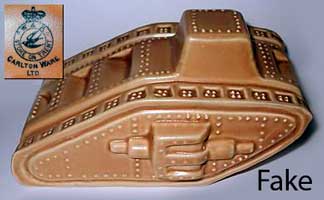
The model of the tank on the left was not made by Carlton Ware.
This uses a fake Crown backstamp shown in the inset. Ltd was not part of the Crown mark.
We think it first appeared in the mid to late 1990s.
This uses a fake Crown backstamp shown in the inset. Ltd was not part of the Crown mark.
We think it first appeared in the mid to late 1990s.
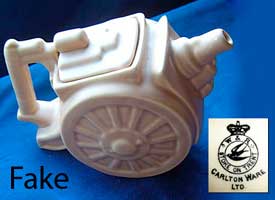
Another fake, purporting to be by Carlton Ware and from WW1, is shown on the right.
A teapot like this, in the form of a gun carriage, was made in the 1930s, possibly by Sadler or Clews, but not by Carlton Ware. It is possible that a fake backstamp has been added to an unmarked example. This too uses the fake Crown mark with the additional Ltd, as shown in the inset.
Below are pictures of a Carlton Ware Heraldic China tank made from about 1916, when the tank was first deployed, and a Sadler tank teapot, believed to be from the 1930s.
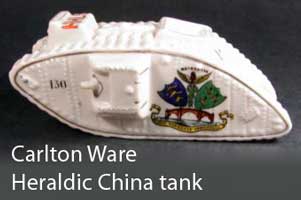
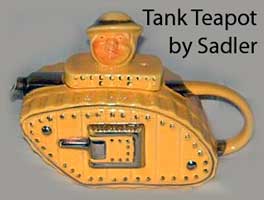
Scroll down for more.
Monday 12 January 2009
Flora and Faun
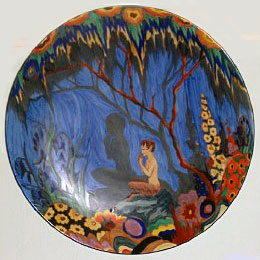
The picture of the Carlton Ware charger on the right, depicting a goat-legged faun or satyr, was sent to us by an Australian collector, who asked if we could provide any information on it, including its pattern name.
The charger came to light some years back.
At the time, there was some controversy as to whether or not it was decorated at Copeland Street, because it was the first time anyone had seen the pattern.
The charger came to light some years back.
At the time, there was some controversy as to whether or not it was decorated at Copeland Street, because it was the first time anyone had seen the pattern.
A script mark identifies it as Carlton Ware, but no pattern number was present.
Could it have been decorated elsewhere on a Carlton Ware blank, like some of the items described on our Monogrammed Mysteries page?
I have always been of the opinion that it was painted on the works and is by Violet Elmer. I have no doubt about this, since it is so typical of her work and uses the palette of colours employed by Carlton Ware. Other obvious Carlton Ware elements are present in the style and form of the tree and flowers, as well as the background shadows, also found on other patterns such as the WILD DUCK , FAIRY and DEVIL patterns, shown below, all of which, in interviews, Miss Elmer assured me were her designs.
Could it have been decorated elsewhere on a Carlton Ware blank, like some of the items described on our Monogrammed Mysteries page?
I have always been of the opinion that it was painted on the works and is by Violet Elmer. I have no doubt about this, since it is so typical of her work and uses the palette of colours employed by Carlton Ware. Other obvious Carlton Ware elements are present in the style and form of the tree and flowers, as well as the background shadows, also found on other patterns such as the WILD DUCK , FAIRY and DEVIL patterns, shown below, all of which, in interviews, Miss Elmer assured me were her designs.
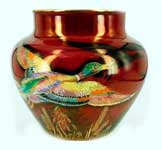
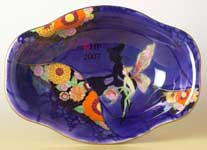
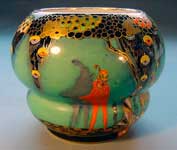
Unfortunately, she had died before the charger surfaced, so we were unable to ask her to confirm our attribution.
The most appropriate name chosen for this design is Faun, since the figure, which is the dominant feature, is in the form of a faun or goat-legged satyr. A satyr is usually depicted with an erect member, so I think Faun is more fitting! Certainly, Miss Elmer, would think so. The Oxford English Dictionary (OED) defines Faun as
One of a class of rural deities; at first represented like men with horns and the tail of a goat, afterwards with goats' legs like the Satyrs, to whom they were assimilated in lustful character. OED QED!
The most appropriate name chosen for this design is Faun, since the figure, which is the dominant feature, is in the form of a faun or goat-legged satyr. A satyr is usually depicted with an erect member, so I think Faun is more fitting! Certainly, Miss Elmer, would think so. The Oxford English Dictionary (OED) defines Faun as
One of a class of rural deities; at first represented like men with horns and the tail of a goat, afterwards with goats' legs like the Satyrs, to whom they were assimilated in lustful character. OED QED!
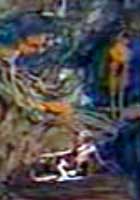
It is not too fanciful to suggest that the Miss Elmer may have been influenced by the set and costume designer Leon Bakst from Diaghilev's Ballets Russes, who still influences designers today.
In this instance, it would be Nijinsky's role as the Faun choreographed to Debussy's L'Aprés-Midi d'un Faune - the music used here. If she had seen pictures of the infamous performance, they may have caught her imagination.
Culture vultures might like to view the short, extraordinary ballet (10 minutes) and see what I mean. To watch it click here. Paris was scandalized by Nijinsky's erotic movements, though, today, such behaviour can be seen in the aisles of Tesco! © Harvey Pettit 2009.
In this instance, it would be Nijinsky's role as the Faun choreographed to Debussy's L'Aprés-Midi d'un Faune - the music used here. If she had seen pictures of the infamous performance, they may have caught her imagination.
Culture vultures might like to view the short, extraordinary ballet (10 minutes) and see what I mean. To watch it click here. Paris was scandalized by Nijinsky's erotic movements, though, today, such behaviour can be seen in the aisles of Tesco! © Harvey Pettit 2009.
Scroll down for more.
Sunday 4 January 2009
Lovely Meter to expire!
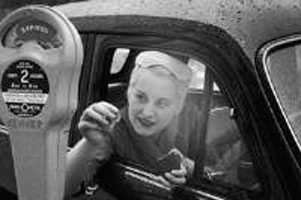
Old style parking meters are to be phased out. The parking meter was introduced to the UK fifty years ago. Its now iconic 'lollipop' form was designed by Kenneth Grange, who also brought us the Kenwood Chef food mixer and the high speed train.
We all learnt to dislike the meters, but you will hate the cashless payment methods that will replace the metal monsters even more.
We all learnt to dislike the meters, but you will hate the cashless payment methods that will replace the metal monsters even more.
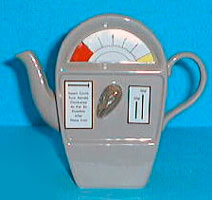
When John McCluskey bought Carlton Ware in 1989 and moved production to his factory in nearby Stone, one of the first things he did was to introduce a range of novelty teapots, which included the parking meter on the right.
London's Westminster Council were the first to adopt the meters in the UK, but now impose a complicated system using your mobile phone and credit card!
First time users will find that the new process can take up to 45 minutes, by which time you could be issued with a parking ticket. It's a good money spinner!
London's Westminster Council were the first to adopt the meters in the UK, but now impose a complicated system using your mobile phone and credit card!
First time users will find that the new process can take up to 45 minutes, by which time you could be issued with a parking ticket. It's a good money spinner!
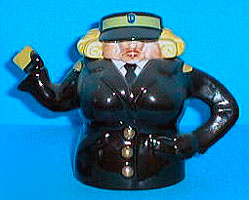
Companions to the model of the coin swallower were the Meter Maid and Wheel Clamp teapots.
I guess that Mr. McCluskey had been victim to all three!
I visited John when he was in the process of making these teapots and was impressed to witness the precision he insisted should go into their manufacture. You will find that the lids to the pots fit extremely well.
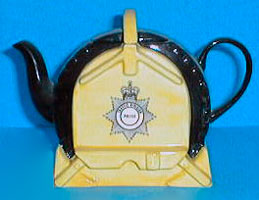
In the 1980s and 90s, when their popularity became apparent, many other potteries jumped on the novelty teapot bandwagon.
Needless to say, it was Carlton Ware who led this renaissance with the work of Roger Michell and Danka Napiorkowska, which began with their Walking Ware teapot, and many others, they devised for Carlton Ware in the 1970s. Harvey Pettit © 2008
Beatles fans can replay Lovely Rita by clicking the replay button in the control at the beginning of this article, or by refreshing the page.
Thanks must go to Sue Blazye of Teapot Island in Maidstone, Kent for the pictures.
Sue holds a certificate from the Guinness Book of Records for her collection of teapots. Teapot collectors will find her site very useful, though navigation is a little difficult.
To access it click here.
Thanks must go to Sue Blazye of Teapot Island in Maidstone, Kent for the pictures.
Sue holds a certificate from the Guinness Book of Records for her collection of teapots. Teapot collectors will find her site very useful, though navigation is a little difficult.
To access it click here.
Images by Harvey Pettit © Copyright 2009. All rights reserved.

